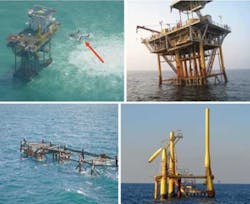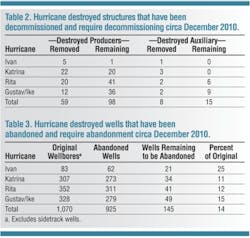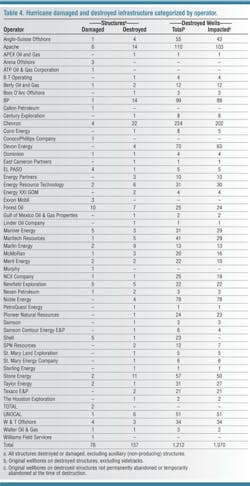Post-hurricane decommissioning poses unique challenges
In the Gulf of Mexico, 67 destroyed structures have been decommissioned to date; more than 100 remain to be removed
Mark J. Kaiser
Center for Energy Studies, Louisiana State University
The offshore oil and gas industry in the Gulf of Mexico is susceptible to natural and man-made disasters. From 2004-2008, five major hurricanes (Ivan, Katrina, Rita, Gustav, Ike) destroyed 180 structures and 1,070 wells (Table 1). In December 2010, 85% of the destroyed wells had been decommissioned but more than half of the destroyed structures remain.
Decommissioning operations on destroyed structures are governed by the same regulations and requirements as normal decommissioning but are subject to unique challenges and are more time consuming and expensive. The cost involved in decommissioning destroyed structures often ranges between 10 to 20 times more than conventional abandonment.
Failure modes
Offshore oil and gas structures are designed for the environmental conditions in which they operate, and as far as day-to-day operations go, are extremely safe and reliable. With the occurrence of a tropical storm or hurricane, however, the risks of damage and destruction increase significantly because structures must sustain wind speeds, wave forces, and potential seabed mudslides that may equal or exceed their design capacity.
Structures fail in different modes. Structural collapse (toppling) is the most common failure, but structures also may be damaged to the point of condemnation. In most cases, there is no visible structure remaining above the waterline. In some cases, the deck and topsides may be sheared off, leaving the jacket in place, or the structure may be leaning. A platform left standing may be declared destroyed if it can no longer carry out its purpose and there is no economic way to ensure structural stability.
Hurricane-destroyed platforms. Source: BOEMRE, Tetra Technologies Inc.
Old structures are especially vulnerable because they are usually designed to lower environmental criteria. Older platforms generally have lower strength characteristics (e.g., weaker joints, less robust bracing patterns, etc.) and lower deck heights which make them more susceptible to wave-in-deck conditions. A wave crest hitting a platform deck creates loads that likely result in significant platform damage and in some cases collapse. A key ingredient in surviving hurricanes is to have a deck elevation above the largest hurricane waves.
Decommissioning challenges
As noted above, decommissioning operations on destroyed structures are governed by the same regulations and requirements as normal decommissioning but are subject to unique challenges and are more time consuming and expensive than normal operations.
Extensive planning
Planning and execution for hurricane destroyed structures is more complicated than normal decommissioning, and operations are subject to additional safety issues and hazards. Extensive planning is required to develop proper work plans, cutting and lifting requirements, and to minimize diver exposure.
Diver exposure and safety
Diving is inherently dangerous under normal conditions with injuries and fatalities commonly associated with burning, jetting, and salvage operations. Conducting these activities in the debris field and among deformed piping/structures expose divers to significantly greater risk if not managed properly. Depending on the location and water depth, there may be limited and at times zero visibility.
Spatial information
To develop work plans and structural analysis models, spatial information for each toppled structure is required. Data collection and analysis employ remote sensing devices, towed side scan sonar, ROV mounted sector scanning sonar, and pole and ROV mounted multibeam echosounder surveys. Unlike conventional operations, finite element and ultimate strength analysis are required at various stages and prior to lift operations.
Debris fields
Large debris fields from deck and structural members, and material and equipment on the decks, are associated with toppled structures. Debris needs to be removed to satisfy site clearance requirements and divers often are employed to identify the debris and to assist in its transfer to the surface. The water depth of the structure and the expected work duration determine the need for air or saturation diving.
Environmental impacts
Wells may either bend or be sheared above, at, or below the mudline. Pipes deform and break. One of the first requirements is to stop leaking wells or to collect the hydrocarbon release. Toppled structures cannot undergo the normal topsides inspection and preparation, but these operations still need to be performed. There are potential environmental hazards due to hydrocarbon release from equipment, tanks, pipelines, etc. and hazardous substances such as batteries and asbestos.
Operational constraints
Dismantling a platform in pieces is one of the most hazardous options due to the extensive diver exposure, duration of operations, and nature of activity. Therefore, it is not frequently performed. Bulk explosives may not be feasible because of the condition of the deformed jacket and because placement may not be possible at the minimum legal depth. Below mud line cutters require diver assistance for excavation and cutting, but uncertain structural issues may preclude this option.
Cost
The cost involved in decommissioning destroyed structures often range between 10 to 20 times more than conventional abandonment because of these factors.
Stages of decommissioning
Unconventional decommissioning follows similar steps to normal decommissioning operations.
Site assessment
The first step is to assess the site and to develop work plans to access the wells safely and to remove debris. Spatial information and structural models are required to plan cutting and lifting operations, well abandonment, and structure removal. Divers and ROVs are used to gather underwater site assessment data and computer assisted drafting is used to create a 3D image of the structure as a visual reference for understanding the access to well bays, conductors, and equipment. Models of the downed structure incorporate the “as built” drawings with the “as is” configuration, and form the basis of engineering analysis and operational planning.
Clearing the structure
Debris over and around the wells is identified and cleared depending on the sequence of cutting and lifting operations. Depending on how the structure collapsed, the legs may pull up over the conductors, wells may pull out of the deck, and wells may be tangled in debris. Wellheads may be inside the deck structure and either inaccessible or accessible but inoperable. Debris may need to be cleared before accessing the well or there may be good access to the wells. The debris field, visibility at the seafloor, and hazards associated with underwater burning expose divers to significant risk.
P&A
Destroyed wells are not in their customary upright (vertical) condition and routine abandonment procedures cannot be implemented. Well access is complicated by the debris field around the toppled structure, the twisted structural members, vessels and piping containing hydrocarbons, and bent pipes and risers. Long arches on conductors indicate they may go deeper than expected, requiring jetting operations to remove soil from around the wellbore. How deep the bends are below the mudline and how much vertical pipe is needed varies with each downed platform. If the well is under pressure, it will be necessary to hot tap. In extreme cases, an operator may have to drill a new well to access the old well.
Pipeline abandonment
Severe weather can move pipelines outside their original bed, break them from risers and junctions, and twist adjacent lines together. The contents of the lines may contain hydrocarbons if they did not drain when the pipe broke. Lines are hot-tapped, flushed, and then cut and removed. Containment domes may be deployed to capture hydrocarbons that might escape during operation. Due to potential stored energy in damaged or deformed pipelines, care must be taken during cutting operations on bent members. Various “strongback” tools were developed by industry to control pipe movement when severed.
Structure removal
Topside facilities, deck, and jacket removal is the core of every decommissioning project and frequently the most expensive stage in normal operations. In conventional decommissioning, sections are removed in the reverse order in which they were installed − deck and topsides equipment, jacket and pile removal. For a destroyed structure, the work paths may overlap and the sequence of cut and lift operations will be specific to the configuration of the structure damage. Following are descriptions of key removal operations.
Conductor removal. Conductors need to be cut and lifted from the seabed. Normally, conductor removal involves three procedures: cutting, pulling/sectioning, and offloading. Cutting requires the use of explosives, mechanical cutters, or abrasive water jets to make the cuts at least 15 ft (5 m) below the mudline. Divers perform the operations or set up the cutting tools. A derrick barge lifts conductors from the seabed. This lifting involves more preparation than similar work in normal operations.
Deck removal. Removing toppled decks pose unique challenges because of their size and weight, location, placement, attachment constraints, and the lack of suitable lift vessels to perform the operation. Dual barge-mounted truss systems were used extensively to remove the decks of toppled structures. Preparing for the deck lift is a complex process. An underwater survey and finite element analysis is used to develop a rigging plan and to estimate the lift weight and loading as the structure is pulled through the water column. Lift assemblies are designed and fabricated, and divers clear loose debris, remove the crane boom and prepare the production equipment by flushing and blinding the open-ended pipes. Access points in the deck need to be cut before installing lifting hooks.
Jacket removal.After the conductors and piles are cut and removed, the jacket structure is lifted out of the water and placed on a cargo barge. If the integrity of the platform is sufficient, the platform can be lifted and transported to shore or to a reef site. Otherwise, the damaged or toppled structure will be cut and removed in pieces, or dismantled in a manner that satisfies site clearance requirements. In some cases, the jacket may be left in place if the site is designated as a Special Artificial Reef Site (SARS) and U.S. Coast Guard clearance requirements can be satisfied. Because of the large number of SARS applications after the 2004-2008 hurricanes, the program is no longer accepting new applicants until a systematic review is complete.
Site clearance and verification
The last stage in decommissioning is site clearance and verification. Site clearance is the process of eliminating, or otherwise addressing, potential problems from debris and seafloor disturbances. Verification ensures that the site is clear of obstructions. For hurricane destroyed structures, the amount of debris is likely to be significantly greater than for normal operations. Cutting leads to more steel members across the site, so divers will be required for clearance which adds to the cost of the operation.
Unconventional decommissioning: the numbers and statistics
A few key statistics regarding decommissioning in the Gulf of Mexico following the 2004-2008 hurricane seasons are provided below.
Structure removal
The number of structures destroyed in the 2004-2008 hurricane seasons that have been removed circa December 2010 are depicted in Table 2. In total, 67 destroyed structures have been decommissioned and 113 destroyed structures remain to be removed.
Most of the remaining structures are previously producing fixed platforms residing within 300 ft water depth. These structures are held by a large number of operators; in total, 36 operators hold between one and 18 structures.
Delays in removal are due likely to the complexity of the operations or redevelopment considerations. All wells at destroyed structures need to be abandoned before the structure can be decommissioned, and delays on well abandonments delay structure removals.
Well abandonment
The number of wellbores associated with the inventory of destroyed structures is shown in Table 3. A total of 1,070 wellbores were destroyed in the storms and a total of 925 wells were permanently and temporarily abandoned through December 2010. Hence, about 85% of the destroyed well inventory has been abandoned.
All the destroyed wells and structures from hurricane Ivan have been decommissioned except Taylor Energy’s eight-pile fixed platform in MC-20 and its 21 remaining wells. Hurricanes Katrina and Rita destroyed 659 wellbores; 584 of these have been abandoned circa December 2010. Hurricanes Gustav and Ike destroyed 328 wells, and 279 of these have been abandoned.
Operator activity
A summary of the damaged and destroyed structures and wells sorted by operator is in Table 4. Chevron, BP, Apache, and Stone had the most destroyed structures and wells over 2004-2008, about 40% of the total inventory.
In December 2010, Chevron has 18 destroyed structures and 34 wells that remain to be decommissioned. Apache and BP have plugged all of their wells and removed about half of their destroyed structures. Anglo-Suisse, Taylor Energy, and Stone Energy each have a dozen or so wells remaining to plug.
A list of operator activity circa December 2010 and a more detailed discussion of the challenges and issues of unconventional decommissioning is available from PennWell.
Editor’s note: This article highlights an upcoming report on Unconventional Decommissioning in the Gulf of Mexico available from PennWell Executive Reports.
Offshore Articles Archives
View Oil and Gas Articles on PennEnergy.com




